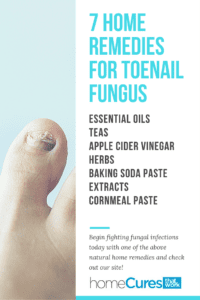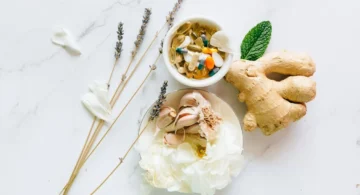7 Ways to Treat Toenail Fungus Naturally & Effectively
Summer is upon us. That means a lot more people are wearing sandals and flip-flops and showing a lot more toe. If you’re a woman, your feet are supposed to be cute. If you’re a man—well, they’re just supposed to look manly. But if you’ve got toenail fungus, your feet will neither look cute, nor manly!
Sure, you could just hide your feet in socks all summer, but we’ve got a better solution.
Toenail fungus is a fungal infection that specifically attacks the toenail. This condition is fairly common, so if you have it, you’re by no means alone. Its technical name is onychomycosis (on-ih-koh-my-KOH-sis). When it first appears, it’s a white or light-yellow spot under the tip of your toenail. If left untreated, toenail fungus can discolor the whole nail. The nail may also thicken, become brittle and begin to flake off on the end.
You can contract toenail fungus by coming into contact with someone else who has it, or in a locker room, pool or hot tub area, or by wearing the same grungy shoes day-in and day-out. [1] With continual warm, moist conditions, your shoes can become a hothouse for fungal growth!
You’re more prone to contract toenail fungus if:
- You’re older or sedentary with decreased blood flow to your feet
- You perspire heavily
- You’re male with a family history of fungal infections
- You work or play in a humid or wet environment
- You wear socks and shoes that don’t breath
- You live with someone who has toenail fungus
- You walk barefoot in communal areas: swimming pools, hot tubs, shower rooms, locker rooms
- You have athlete’s foot
- You have a minor cut or injury that makes you susceptible to infection
- You have diabetes, circulation issues, or a weakened immune system
Sometimes toenail fungus is merely unsightly and may emit a foul odor. But it can become painful and even cause permanent damage to your toenails. If left untreated, toenail fungus can lead to other health issues and infections that attack other parts of your body.[2]
Toenail Fungus Prevention
Here are 7 common-sense precautions you can take to avoid toenail fungus:
- Stay active, especially as you grow older. This will help your circulation and keep blood flowing to your feet, which removes bacteria and fungus. Regular aerobic exercise also helps keep your immune system in good order.
- Maintain a strong immune system. In addition to regular exercise, eating nutritious, whole foods that are good for your gut is extremely important. Also, take a probiotic to aid in maintaining a healthy gut. The lactobacillus bacteria in most probiotics secrete a substance that kills fungi.[3] Also, reduce your stress level by maintaining healthy relationships and by purposeful living.
- Facilitate treatment for someone you live with who has toenail fungus. If you notice that your spouse, child, or roommate has toenail fungus, help them with treatment and avoid direct contact with their infected area. Take extra care in keeping common areas clean.
- Wear breathable shoes and change your socks daily. If your job or activities require you to be on your feet a lot, consider wearing socks made from wicking material to keep the moisture away from your feet. Also, when you get home, take off your shoes and socks and let your feet air out. Wash them daily.
- Wear flip-flops or aqua-shoes in public areas. If you frequent the pool, locker room, or some other public place, avoid walking barefoot in those areas.
- Treat athlete’s foot right away. If you do contract athlete’s foot, treat it immediately to avoid toenail fungus and other spread of infection.
- Attend to cuts and scrapes on your feet at once. Any open wound on your foot provides a gateway for fungal infection or bacterial infections. Cleanse wounds with antiseptic and protect the injured area.
An ounce of prevention may be worth a pound of cure, but what if you or someone you know already has toenail fungus? I’m glad you asked! If you go to your doctor for treatment they may suggest any of the following treatments or combination thereof:[4]
- Oral antifungal drugs, usually taken for six to 12 weeks. Caution: “Oral antifungal drugs may cause serious side effects ranging from skin rash to liver damage.”[5]
- Medicated nail polish applied for as long as one year
- Medicated antifungal nail cream combined with thinning your nails through use of a urea lotion and nail file
- Removal of nail surgically so that a new nail can grow in its place
But of course, at Barton Publishing we always encourage the more natural, home-remedy path whenever possible. Fortunately, in the case of toenail fungus, there are a number of effective treatments you can apply, some of which you may already have in your pantry.
7 Home Remedies for Toenail Fungus
- Essential oils – All of the following essential oils have powerful antifungal properties: tea tree oil, lavender oil, oregano oil, and turmeric oil. Dr. James Duke recommends blending two or more such oils together. Researchers have concluded that “combinations of the antifungal essential oils increased their activity remarkably.”[6] Mix essential oils with an organic carrier oil and apply with a cotton swab three times daily until the fungus clears up.
- Teas – Both chamomile tea and lemongrass tea contain antifungal compounds. Dr. Duke recommends both drinking the tea and applying it to the infected area. If you’re using a tea bag, you can simply use the spent tea bag to dab the infected area. Do this two to four times daily until the fungal infection is gone.[7]
- Apple cider vinegar – This natural home remedy is counterintuitive because we tend to think of apple cider vinegar (ACV) as being acidic and acid promotes yeast infections. However, when consumed, ACV turns alkaline.[8] Therefore, as with teas, you can take ACV internally and apply it topically to your toes. For a drink, mix two tablespoons of organic ACV and 8 ounces of warm water. Add a teaspoon of honey to make it tasty. You can use equal parts ACV and Epsom salts mixed with six parts hot water to make a therapeutic footbath. Soak your feet two times a day for at least 30 minutes until symptoms are gone.[9]
- Herbs – Any herb that contains Berberine is a potent antifungal. Some of these herbs include: goldenseal, Oregon grape, and yellowroot. Again, as with essential oils, it’s best to mix these herbs into a paste to apply to the affected area. “The research is quite clear: Mixtures of antifungal herbs almost always work better than single herbs.”[10]
- Baking soda and sodium borate paste – Sodium borate is a naturally occurring mineral. Both of these substances are alkaline and therefore powerful antifungals. When blended together in equal parts and mixed with enough water to form a paste, they create a hostile environment for toenail fungus. Apply this mixture twice daily to infected toenails and continue for two weeks after the fungus has gone.[11]
- Extracts – Extracts or tinctures are different than essential oils in the way they’re extracted and bottled, often in alcohol. Examples of antifungal extracts are: snakeroot extract, olive leaf extract, and licorice extract. Licorice extract alone contains at least 25 antifungal compounds![12] Again, we recommend that you use them in combination with each other.
- Cornmeal paste – Although this natural remedy seems the most unlikely, it may be one of the most popular natural approaches to killing toenail fungus. For eons, gardeners have used cornmeal to kill fungus in flowerbeds and on lawns. Its antifungal properties appear to work on toenail fungus as well. In a container suitable for a footbath, mix equal parts of organic corn meal and warm water and let sit for about an hour. Then add enough warm water to submerge your whole foot and let soak for an hour. With a clean towel dry off your foot. Repeat often until you see results.[13]
Toenail fungus can be significantly more serious than finding yourself embarrassed to wear sandals. If you or your loved one has toenail fungus, begin fighting it today with one of the above natural home remedies and let us know about your success.
Here’s to good looking and healthy feet!
Oregano is a strong antifungal antioxidant that supports immune system health, turmeric has antibacterial and anti-inflammatory properties and garlic provides cardiovascular and antimicrobial benefits, so use them liberally in all your winter recipes.



















